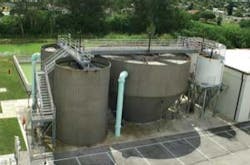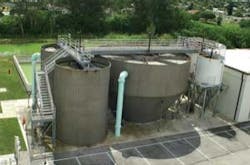New X-ray technique illuminates reactivity of environmental contaminants
Sept. 15, 2009 -- Thanks to a new analytical method employed by researchers at the University of Delaware, scientists can now pinpoint, at the millisecond level, what happens as harmful environmental contaminants such as arsenic begin to react with soil and water under various conditions.
Quantifying the initial rates of such reactions is essential for modeling how contaminants are transported in the environment and predicting risks.
The research method, which uses an analytical technique known as quick-scanning X-ray absorption spectroscopy (Q-XAS), was developed by a research team led by Donald Sparks, S. Hallock du Pont Chair of Plant and Soil Sciences and director of the Delaware Environmental Institute at UD. The work is reported in the Sept. 10 Early Edition of the Proceedings of the National Academy of Sciences and will be in the Sept. 22 print issue.
The research method was developed using beamline X18B at the National Synchrotron Light Source at Brookhaven National Laboratory in Upton, N.Y. The facility is operated by the U.S. Department of Energy.
"This method is a significant advance in elucidating mechanisms of important geochemical processes, and is the first application, at millisecond time scales, to determine in real-time, the molecular scale reactions at the mineral/water interface. It has tremendous applications to many important environmental processes including sorption, redox, and precipitation," Sparks said.
"My group and I have been conducting kinetics studies on soils and soil minerals for 30 years," Sparks added. "Since the beginning I have been hopeful that someday we could follow extremely rapid reaction processes and simultaneously collect mechanistic information."
X-ray spectroscopy was invented years ago to illuminate structures and materials at the atomic level. The technique has been commonly used by physicists, chemists, materials scientists, and engineers, but only recently by environmental scientists.
"In studying soil kinetics, we want to know how fast a contaminant begins to stick to a mineral," Ginder-Vogel says. "In general, these reactions are very rapid -- 90 percent of the reaction is over in the first 10 seconds. Now we can measure the first few seconds of these reactions that couldn't be measured before. We can now look at things as they happen versus attempting to freeze time after the fact," he notes.
For their study, the UD researchers made millisecond measurements of the oxidation rate of arsenic by hydrous manganese oxide, which is a mineral that absorbs heavy metals and nutrients.
Contamination of drinking water supplies by arsenic is a serious health concern in the United States and abroad. The poisonous element occurs naturally in rocks and minerals and is also used in a wide range of products, from wood preservatives and insecticides, to poultry feed.
The toxicity and availability of arsenic to living organisms depends on its oxidation state -- in other words, the number of electrons lost or gained by an atom when it reacts with minerals and microbes. For example, arsenite [As(III)] is more mobile and toxic than its oxidized counterpart, arsenate [As(V)].
"Our technique is important for looking at groundwater flowing through minerals," Ginder-Vogel notes. "We look at it as a very early tool that can be incorporated into predictive modeling for the environment."
The research was funded by the U.S. Department of Agriculture (USDA) and by two grants from the National Science Foundation, including one from the NSF-Delaware Experimental Program to Stimulate Competitive Research (EPSCoR). The U.S. Department of Energy supported the research team's use of the National Synchrotron Light Source.
###

